Adeyemo Florence O. 1, Ohaeri Beatrice 2, Pat U. Okpala 3, Ogodo Oghale 4
1Dept of Nursing, College of Health Sciences, Ladoke Akintola University of Technology, Ogbomoso, Nigeria
2Dept of Nursing, College of Medicine, University of Ibadan, Ibadan, Nigeria
3Dept of Nursing, University of Nigeria, Enugu Campus, Nigeria
4Dept of Nursing, College of Medical Sciences, University of Benin, Benin City, Nigeria
Correspondence to: Adeyemo Florence O. , Dept of Nursing, College of Health Sciences, Ladoke Akintola University of Technology, Ogbomoso, Nigeria.
| Email: |  |
Copyright © 2016 Scientific & Academic Publishing. All Rights Reserved.
This work is licensed under the Creative Commons Attribution International License (CC BY).
http://creativecommons.org/licenses/by/4.0/

Abstract
Drug Abuse is becoming an increasing problem in Nigeria. This study sought to determine the prevalence of drug abuse among students in a tertiary institution in Benin City, Edo State, Nigeria. The study adopted a descriptive survey design. The sample size for this study was 800 students (n=800). Structured questionnaire was used to collect data. Three research questions and one hypothesis was answered. Descriptive statistics and Pearson product moment correlation were used for data analysis using the statistical package for social sciences (SPSS). Results showed that majority of the respondents were young people within the age group of 20-25 years and a higher proportion of respondents were male students. This study reveals that 46.6% of the sample respondents have taken drugs for non-medical purposes at least once. Coffee and alcohol were the most commonly abused drugs. Majority of the respondents agreed that students take drugs as a result of poor teacher-student relationship, improper parental upbringing, as well as the influence of peer pressure. Results also revealed that the null hypothesis which states that there is no significant relationship between university environment and drug abuse among UNIBEN students is rejected while the alternate hypothesis is upheld. It is therefore recommended that Public health intervention aimed at preventing drug use among students should be designed to raise awareness about the negative effects of drug abuse.
Keywords:
Prevalence, Drug abuse, Students
Cite this paper: Adeyemo Florence O. , Ohaeri Beatrice , Pat U. Okpala , Ogodo Oghale , Prevalence of Drug Abuse Amongst University Students in Benin City, Nigeria, Public Health Research, Vol. 6 No. 2, 2016, pp. 31-37. doi: 10.5923/j.phr.20160602.01.
1. Introduction
The prevalence of health-risky behaviors associated with adolescent illicit drug use has attracted growing international recognition. Especially in southern Africa, unsafe sexual behaviors may have significantly untoward consequences, considering the high HIV prevalence estimates from the region (Garvin et al., 2006). Unfortunately, adolescents and youth may underrate the harmful effects of unhealthy life styles (McMaster and Keshav, 1994). These unpleasant youthful activities are widespread in Nigeria and all over Africa, thus giving a lot of concern to the government and general public (Greene, 1980). Drug abuse remains a major health challenge all over the world (UNODC, 2005). Haladu (2003) describes drug abuse as excessive and persistent self-administration of a drug without regard to medically or culturally acceptable patterns. Odejide (2000) posited that a drug is said to be abused when its use is not pharmacologically necessary especially when it’s used in face of legal prohibition or when socially acceptablebeverage is used excessively. Drug abuse may lead to organized crimes and disruption of normal academic programmes. It has led to increased secret cult activities in secondary schools and most Nigerian universities, which has been a source of threat to lives and properties (Aluede, 2000). The impact of drug abuse among Nigerian youths has also been associated with the loss of our societal values and ideals (Aluede, 2000). Drugs alter the normal biological and psychological functioning of the body, especially the central nervous system (Melis et al., 2005). Majority of the Nigerian youths ignorantly depend on one form of drug or the other (such as Tobacco, Indian hemp, cocaine, morphine, Heroine, Alcohol, ephedrine, Madras, Caffeine, Glue, Barbiturates and Amphetamines) for their various daily activities (Oshikoya and Alli, 2006). Oshikoya and Alli (2006) in their studies on perception of drug abuse amongst Nigerian undergraduates also identified dependence and addiction as one of the major consequence of drug abuse, characterized by compulsive drug craving seeking behaviours even in the face of negative consequences. Maithya (2009) revealed that the common reasons for drug abuse amongst secondary school students in Kenya are mostly out of curiosity and acceptance by friends (peer pressure). A study by Kiiru (2004) showed that peer pressure was responsible for youths’ consumption of drugs for the purpose of stimulating appetite for food. Ndom and Adelakun (1996) argued that male children from an unstable families were associated with high risk of substance abuse, this argument is supported with clinical findings by Nyki (2015) indicates that cannabis abusers are mostly young Nigerian men, including students, who have been deprived of parental supervision and warmth from infancy. Awoyinfa (2012) argued that the very high rate of alcohol use and abuse among students in secondary and tertiary institutions in Nigeria began from their childhood or early adolescence. At times youth, including students, who hawk for their parents, are themselves exposed to substance abuse. Some youths will experiment and stop, or continue to use occasionally without significant problems. Others will develop addiction, moving on to more dangerous drugs and causing significant harm to themselves and the society at large (Pela, 1989). Despite the effort of many concerned bodies to curb this menace, many organizations and individuals still present these drugs as though they are harmless which often lure irrational youths into drugs and alcoholism. Drug use amongst young people should be a matter of concern to all Nigerians especially the government, school heads, the leaders of various religious groups and other NGOs. This study therefore aimed at establishing the prevalence of drug abuse amongst students in university of Benin (UNIBEN). Statement of ProblemThe health of young people is a key factor in the promotion and preservation of the health of the population as a whole because it determines the overall level of population health in the short term (Tsvetkova and Antonova, 2013). There seem to be an increasing prevalence of drug abuse amongst adolescents (university students inclusive) despite the efforts of concerned bodies to curb this menace. University students are the most susceptible to drug use amongst different youth groups in Nigeria because most of them live outside the watch of their parents or guardian. Hence, a comprehensive empirical study on the prevalence of drug abuse amongst university students in Benin. Objectives of the StudyThe main objective of this research is to find out the prevalence of drug abuse amongst university students in Benin.The specific objectives of the study are as follows to:1. Assess the prevalence of drug abuse amongst university students in Benin.2. Identify types of drugs that are commonly abused.3. Identify the factors responsible for drug abuse among the students.Research QuestionsThe study attempts to answer the following questions1. What is the prevalence rate of drug abuse amongst the university students in Benin?2. What types of drugs are commonly abused by the students?3. What are the factors that influence the consumption of these drugs?HypothesisThere is no significant relationship between university environment and drug abuse amongst university students in Benin City.Ethical ConsiderationsPermission for the study was obtained from the ethics committee and authorities of the University of Benin. A written informed consent was also gotten from the participants after clear education on the need for the study and their rights to give or refuse consent. All data were handled with strict confidentiality.Research MethodologyResearch design: descriptive surveySetting of the study: The study was carried out in University of Benin, Benin City, Edo state. Benin City is situated approximately 25 miles North of the Benin river and situated 200 miles by road east of Lagos. The university has a population of about 50,000 students comprising of part time, full time and post graduate students.Research population: The target population for this study were male and female from the following four faculties; basic medical Sciences, Engineering, law and social sciences. This consists of a total population of 7,570 students. Sampling technique: Multi-stage sampling technique was used. Four faculties were randomly selected, then four departments randomly selected and this was followed by the systematic sampling which involved administering the questionnaire to every 50th person in each department, making a total sample size of 800 students. Instrument for data collection: Questionnaire was used to elicit data from the students. The questionnaire had four sections which included the students’ demographic data, prevalence of drug abuse, commonly abused drugs and factors influencing students into drug abuse. These instruments were self-administered and were pretested before the commencement of the study.Reliability of the study: The department of Arts was used for the pilot study, this was considered important because comments and suggestions by respondents during pre-testing helped improve the quality of the questionnaire. Test re-test was used for measuring there liability. The reliability value was 0.79.Procedure for data collection: 8 Research assistants were recruited from the researcher’s departmentMethod of data analysis: Data was analyzed with frequency tables and percentages. Pearson product moment correlation was also used to test the hypothesis by using the Statistical Package for Social Sciences (SPSS). Ethical consideration: A permit was obtained from the chairman of research committee, university of Benin and informed consent from all respondents. The questionnaires were clearly explained to the selected students before and during the process of answering them.
2. Results
The result from table 1 indicates that four faculties participated in the prevalence of drug abuse among students in university of Benin survey, the four faculties have equal number of respondents. The information is presented graphically in table 2.Table 1. Frequency distribution of sampled students in each faculty
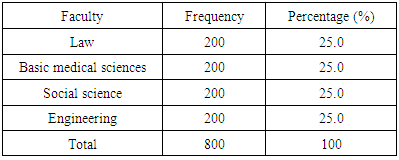 |
| |
|
Table 2. Frequency distribution of sampled students by departments
 |
| |
|
Thirteen (13) departments were sampled in the study; the department of law had the highest respondents (25.0 %), while other department had 6.3 per cent as shown in table 2.The compartmentalisation of the gender of respondents show that male students constituted 55.8 per cent of the sample while females in the sample were 44.3 per cent as shown in table 3.Table 3. Frequency distribution of gender
 |
| |
|
The respondents (students) are between one hundred (first year) and five hundred level (fifth year), but the four hundred level students (fourth year) formed the bulk of the subjects used for the study (36.3%), the group with the smallest number of participants is one hundred level students (3.0%) as shown in table 4.Table 4. Frequency distribution of students’ level
 |
| |
|
A greater proportion of the subjects were between the ages of 20 – 25 year, followed by those in the age bracket of less than 20years while those whose ages were 26years and above were just (14.4%) as shown in table 5.Table 5. Frequency distribution of students’ age
 |
| |
|
Majority of the respondents practice Christianity (97.6%), followed by Muslim (1.8%) and just (0.6%) practice African traditional religion as shown in table 6.Table 6. Frequency distribution of religious affiliation
 |
| |
|
Presentation of resultsIn this section each of the research questions is re-stated and the statistical analysis carried out to answer it. Frequency and percentage was used to answer.Research question one● What is the prevalence rate of drug abuse among students in university of Benin? To answer this research question the frequency count and percentage of students’ response was analysed and presented in table 8.Table 7 shows the students response in relation to drug abuse, the result reveals that out of eight hundred (800) respondents who participated in the study, three hundred and fifty one 351 (43.9%) have taken drugs other than for medical purpose. 411 (51.4%) have not taken while 38 (4.8%) students did not respond to the item. Therefore 46.6% of the sample respondents have at one time or the other used drugs for non-medical purposes.Table 7. Prevalence rate of drug abuse
 |
| |
|
Result in table 8 reveals that majority of the respondents (82.0%) did not respond to the item measuring the duration of drug abuse, 77.08% of respondents who responded to the item have been taking drug for less than four years, while 12.5% have taken drug more than four to five years and only 10.41% have taken drug more than six years and above. The large percentage of respondents who have taken drug less than four years could be subjects with a four year academic programme on the average.Table 8. Shows duration of drug abuse by the students: Frequency and percentages were used to answer this research question
 |
| |
|
Result in table 9 shows that majority of the respondents disagreed to item “1 and 3”. “Is any member of your family a drug abuser?” (69.1%), Have you engaged in illegal activities to obtain any drugs? (82.9%) while 59.6% agreed to “item 2” Do you feel normal /okay when some drugs are not at your reach? This implies that the factors that instigate students to take drugs are external or environmental, coupled with ease of access.Table 9. Showing factors that instigate drug consumption
 |
| |
|
Results in table 10 reveals that majority of the respondents ticked “no” to items “1 to 5”. Are these drugs in readily available in the school? (55.5%); Have you been taken drugs before gaining admission into the university? (71.9%); did you start taking drugs when you gained entry (admission) into the university? (79.6%); has the university environment influenced you in the use of drugs? (79.9%) and is drug abuse common in your faculty? (72.1%). The large number of persons who disagreed to the items show that accessibility to drug is low within the school environment. This implies that the rate of drug abuse among UNIBEN students is high. Furthermore table 9 reveals the drugs commonly abused by students.Table 10. Students accessibility to drug
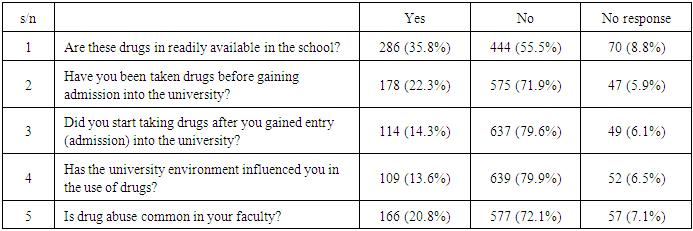 |
| |
|
Research question two ● Which types of drugs are commonly abused by the students?To answer this research question the frequency count and percentage of students’ response was analysed and presented in table 8.Table 12 reveals that out of the eight (8) commonly abused substance/drugs, the rate of abuse varies. Students seem to abuse the following type of drugs respectively: Coffee 294 (36.8%); Alcohol 237 (29.6%); Spirit 237 (29.6%); Kola nut 128 (16.0%); Cigarette 103 (12.9); tobacco 84 (10.5%); Marijuana (Weed) 78 (9.8%) and Cocaine 52 (6.5%). The result presented is from a sample of 800 students, but only 300 students responded to the items while about 500 students did not tick so show their agreement or disagreement.Frequency and percentage will be used to explain this research questions.Table 11. Frequency of commonly abused drugs among the university students
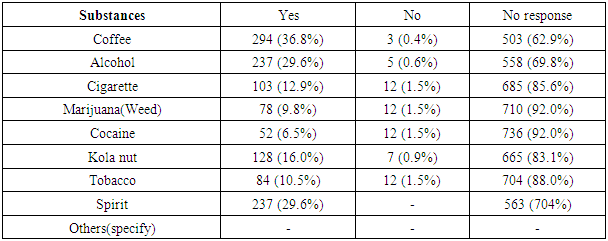 |
| |
|
Research question three ● What are the factors that influence students into taking of these drugs? To answer this research question the frequency count and percentage of students’ response was analyzed and presented in table 12.Table 12. Frequency of factors influencing drug consumption among the university students
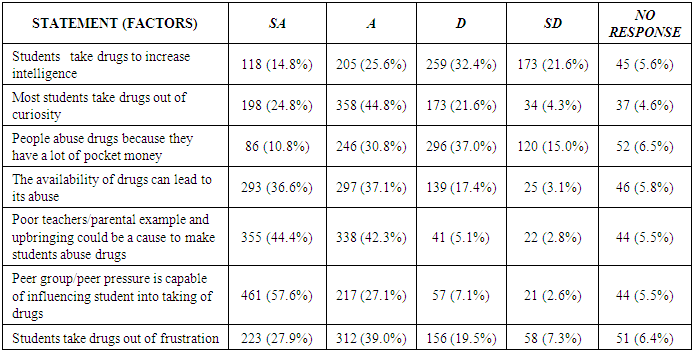 |
| |
|
Table 12 reveals the factors influencing drug abuse among the university students. Students seem to show agreement (SA & A ) to the following as potent factors in drug abuse amongst the university students: Most students take drugs out of curiosity “556” (69.6%), The availability of drugs can lead to its abuse “590” (73.7%), Poor teachers/parental example/ improper upbringing could be a factor in students abuse drugs “693” (86.7%), Peer group/peer pressure is capable of influencing student into taking of drugs“678” (84.7%) and Students take drugs out of frustration “535” (66.9%).The respondents sampled showed disagreement (SD & D) to the following items: students abuse drugs to increase intelligence“432” (54.0%), People abuse drugs because they have a lot of pocket money“416” (52.0%). In furtherance, Table 13 explains peer influence on drug abuse among the university students.Table 13. Frequency of “peer influence amongst the students in the consumption of drugs?”
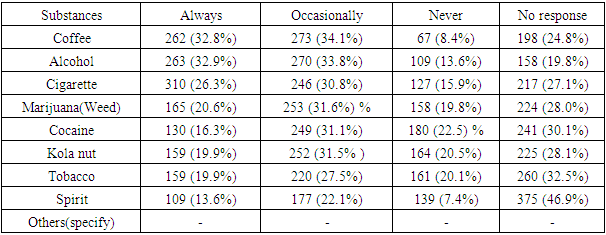 |
| |
|
Table 13 reveals students response in relation to peer influence on drug use and types of drug. Majority of the respondents agreed that (always or occasionally) friends encourage them to take: Coffee 535(66.9%); Alcohol 533 (66.7%); Cigarette 344 (57.1%); Marijuana (weed) 418 (52.2%) and Kola nut 411 (51.4%).Majority of the students seem to show disagreement (never or no response) to the taking of the following drug type: Cocaine 421 (52.6%), Tobacco 421 (56.2%) and Spirit 514 (54.3%).
3. Hypothesis
There is no significant relationship between university environment and drug abuse among the university students. The independent variable in this hypothesis is university environment while the dependent variable is drug abuse, Pearson product moment was used to analyse the data collected and presented in table 14.Table 14. Pearson product moment correlation between university environment and drug abuse
 |
| |
|
The result in table 14 reveals that the calculated r – value of 0.713* is greater than the critical r-value of 0.170 at .05 level of significance with 798 degree of freedom with this result, the null hypothesis which states that there is no significant relationship between university environment and drug abuse among the university students is rejected while the alternate hypothesis is upheld.
4. Discussion of Findings
Eight hundred students from four faculties and sixteen departments (four departments in each faculty) were randomly selected to participate in this study. Majority of the respondents are Christians followed by Muslim and African traditional religion respectively. Majority of the respondents were young people within the age group of 20-25 years which is in line with the findings of Nevadomsky (1985) and in contrast with findings from the study conducted by Otiena (2009) and Odejide (2000) which reported mean age of most respondents (drug abusers) to be about 18 years respectively.The study also revealed that a higher proportion of respondents were male students and this suggests that the compulsive use of drugs is associated majorly with male gender which is in line with the study of Enakpoya (2009). The gender differences in drug abuse are said to have their foundation in the very first stage of drug involvement and the opportunity to use the drugs. If given the opportunity to use the drugs, male and female are equally likely to use them (Anthony et al., 1999).The result of this study further reveals that 43.9% of the sample respondents have in one time taken drugs for reasons other than for medical purposes which is an upsurge as compared to the study conducted by Maithya (2009) which showed that 29.6% students reported drug use other than for medical purposes. Singh and Singh (1979) in their findings also showed that 7 out of 10 undergraduate students had used drugs in the past [the commonest was alcohol (58%)].Coffee and alcohol were the most commonly abused drugs (36.8%) and (29.6%) respectively, this is however consistent with finding from advisory council on the misuse of drugs (2006) that says alcohol is the most popular drug misused by young people. Only very few respondents abuse cocaine (6.5%), this is similar to the finding by Adelekan (1999) who showed that the consumption of cocaine amongst youths in rural area was quite low. The study explained that majority of respondents did not respond to this question, but 77.08% of respondents who responded to the item have been taking drug for less than four years. This is in line with the study conducted by the National Survey on Drug Use and Health (Andrews et al., 2001) which revealed that more than half of the students in the U.S tried an illegal drug before they graduated from high school.Majority of the respondents agreed that students take drugs as a result of poor teacher/ parental upbringing and also the influence of peer pressure, this correlates with studies conducted by Maithya (2009) and Kiiru (2004) which showed that some students take drugs as a result of poor teacher/parental role modelling and influence of peer pressure respectively.Lastly, result also revealed that the null hypothesis which states that there is no significant relationship between university environment and drug abuse amongst university students in Benin is rejected while the alternate hypothesis is upheld. This implies that, there is significant relationship between university environment and drug abuse amongst the university students especially those residents in the school hostels.
5. Conclusions
The study shows that an average number of students (43.9%) in University of Benin were exposed to drugs. Alcohol and coffee were the most commonly abused drugs and the least was cocaine. There is an increasing trend in Nigeria and other developing countries. Also students have difficulties stopping habitual use of alcohol. Most students abuse drugs as a result of poor teacher/parental upbringing and also the influence of peer pressure. There is need for early intervention that targets tertiary school students. More students should be made to develop drug abuse prevention strategies that target students at high risk. Appropriate intervention, health education efforts, support and referral system should be established in tertiary institution to help curb this habit and counseling programmes be incorporated into the Universities health care system (Kiiru, 2004).
6. Recommendations
The following recommendations were made on the basis of the findings of this study:1. Preventive health education should be intensified in schools and media to raise students’ awareness of risks of drug abuse. Media should be used to address drug abuse because of its great influence on the youths.2. Any education programme aimed at addressing drug abuse among students should therefore be wholistic and address both the risk and protective factors. The aim should be to strengthen the protective factors where potential buffers include strong family bonding, positive role models, school commitment and strong belief in one’s own efficacy. Parents require information on how to be good role models and the right values by family members 3. Benefits of healthy lifestyle choices and development of skills needed in making informed and responsible decisions to resist drug abuse among students should be emphasized.4. The government should enforce laws to regulate the production and consumption of the local breweries which seem to be the bases where students learn the behaviour of alcohol abuse.
References
| [1] | Adelekan, M. (1999). Rapid Situation Assessment of the Drug Situation at Ehin – Etiri, Ijebu North Local Government, Ogun State Nigeria. Lagosi: UNDCP .African Journal of Drug & Alcohol studies. |
| [2] | Andrews, J., Smolkowski, K., Hops, H., Tildesley, E., Ary, D., & Harris, J. (2001). Adolescent substance use and academic achievement and motivation. Paper presented at the Annual Convention of the American Psychological Association, San Francisco, CA (ERIC Document Reproduction Service No. ED 337 733). |
| [3] | Anthony, J.C., Etten, M.C., Newmark, Y.D. (1999). Male to female Differences in the earliest stages of drug involvement. Addiction, 642-644. |
| [4] | Awoyinfa, J.O. (2012). An Investigation into the Incidence of Alcohol Usage and Abuse among Female Student of the University of Lagos, Nigeria, West Africa. Journal of Emerging Trends in Educational Research and Policy Studies, 3(2), 174-178. |
| [5] | Enakpoya, E. (2009). Prevalence of drug abuse among Nigerian adolescents: Implication for Counseling. The Counsellor, 26 (2). |
| [6] | Ekpenyong, S.N (2012) Drug Abuse in Nigerian Secondary Schools, Wilberforce Island, Nigeria. International Journal of Scientific Research in Education, 5(3), 260-268. |
| [7] | Gavin, L., Galavotti, C., Dube, H., McNaghten, A.D., Murwirwa, M., Khan, R., et al. (2006). Factors associated with HIV infection in adolscents in females in Zimbabwe. J Adolesc Health, 39, 596-598. |
| [8] | Greene, B.J. (1980). Sequential use of drugs and alcohol: A re-examination of the stepping-stone hypothesis. Am J Drug Alcohol Abuse, 7, 83-99. |
| [9] | Haladu, A. A., (2003) Outreach strategies for curbing drug abuse among out-of-school youth in Nigeria: A Challenge for Community Based Organization (CBOS) in A Garba (ed) youth and drug abuse in Nigeria. Strategies for counseling management and control. |
| [10] | Kiiru, D. (2004). Youth in Peril: Alcohol and Drug Abuse in Kenya. Nairobi: NACADA. |
| [11] | Maithya, R.W. (2009). Drug Abuse in Secondary Schools in Kenya; Developing a Programme for its Prevention and Control. Central Division of Machakos District, Kenya. Asian Journal of Medical sciences, 29-36. |
| [12] | McMaster, J., Keshav, C. (1994). Perceptions of normal alcohol use held by Zimbabwean high school students. Cent Afr J Med., 88-94. |
| [13] | Melis, M., Spigga, S., and Marco, D. (2005). The Dopamine Hypothesis of drug Addiction: Hypo-dopaminergic state. Int. Rev. Neurobiol., 63, 101-154. |
| [14] | Ndom, R. and Adelekan, M. (1996). Psychosocial correlates substance use among undergraduates in Ilorin University, Nigeria. East African medical journal, 73(8), 541-547. |
| [15] | Nkyi, A. (2015). Adolescents’ Use of Alcohol, Tobacco, and Marijuana: The Gateway to Other Drugs. International Journal of Psychology and Behavioral Sciences, 5(4),158-168. |
| [16] | Odejide, A. O., (2000). Research, prevention and treatment of alcohol and drug abuse in Nigeria Problem and Prospects. Paper presented at the 10th. Anniversary Lecture of CRISA JOS. |
| [17] | Oshikoya, K.A. and Alli, A. (2006). Perception of Drug Abuse Amongst Nigerian Undergraduates. World Journal of Medical Sciences, 1(2), 133-139. |
| [18] | Otieno, A.O. (2009). Drug abuse in Kisumu town western Kenya. African journal of food and agricultural nutrition and development, 9(3), 846-888. |
| [19] | Singh, G, Singh RP. (1979). Drugs on a medical campus I. Drug use among medical undergraduates. Drug and alcohol dependence, 4 (5), 391–398. |
| [20] | Tsvetkova, A., and Antonova, A. (2013). The prevalence of drug use among university students in st. Petersburg. Russia Psychology in Russia, 6(1), 86-94. |
| [21] | Pela, O.A. (1989). Drug use and attitudes among College Students in Benin City, Nigeria. |
| [22] | Journal of Alcohol and Drug Education, 34(3), 5-13. |
| [23] | UNODC, (2005). World Health Organization Expert Committee on Dependence Producing Drugs. Fourteenth Report Urban Adolescent. Child Development, 61, 2032-2046. |



 Abstract
Abstract Reference
Reference Full-Text PDF
Full-Text PDF Full-text HTML
Full-text HTML












